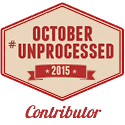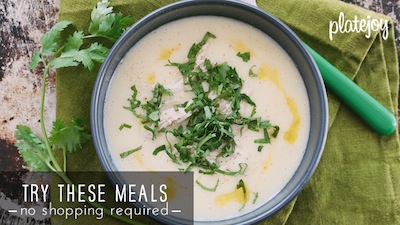For some reason, we have no problem buying a pair of pants (that are obviously too long in the leg and trail dangerously past your shoes) and taking them to the local tailor to be shortened, cuffed, and fitted. But when it comes to following a recipe, we seem reticent (if not frightened) to change any detail to fit our needs, as if altering instructions from Julia Child’s cookbook is akin to telling Coco Chanel she got her pantsuit all wrong. But we have to get over that fear for two reasons: (1) adaptation is essential to low sodium cooking and (2) creativity is key to good cooking in general.
So today, I wanted to break down for you the method I use to morph normal recipes into delicious, low sodium versions. It is not as difficult as one would think and in doing this little exercise, you will realize that you already have the skills and imagination to make similar changes on your own.
Here’s the challenge: a traditional Chicken Parmesan. Why is this difficult? Between the bread crumbs, cheese, and canned tomato sauce, you are talking lots of sodium. But with a few substitutions, and culinary liberties, it is easy to get close to the classic without all the salt. And by making these changes, the classic becomes an original.
Let’s begin with some inspiration – a recipe from Food Network’s Tyler Florence:
Ingredients:
- 1/4 cup extra-virgin olive oil, plus 3 tablespoons
- 1 medium onion, chopped
- 2 garlic cloves, minced
- 2 bay leaves
- 1/2 cup kalamata olives, pitted
- 1/2 bunch fresh basil leaves
- 2 (28-ounce) cans whole peeled tomatoes, drained and hand-crushed
- Pinch sugar
- Kosher salt and freshly ground black pepper
- 4 skinless, boneless, chicken breasts (about 11/2 pounds)
- 1/2 cup all-purpose flour
- 2 large eggs, lightly beaten
- 1 tablespoon water
- 1 cup dried bread crumbs
- 1 (8-ounce) ball fresh buffalo mozzarella, water drained
- Freshly grated Parmesan
Directions:
1. Coat a saute pan with olive oil and place over medium heat. When the oil gets hazy, add the onions, garlic, and bay leaves; cook and stir for 5 minutes until fragrant and soft. Add the olives and some hand-torn basil. Carefully add the tomatoes (nothing splashes like tomatoes), cook and stir until the liquid is cooked down and the sauce is thick, about 15 minutes; season with sugar, salt and pepper. Lower the heat, cover, and keep warm.
2. Preheat the oven to 450 degrees F.
3. Get the ingredients together for the chicken so you have a little assembly line. Put the chicken breasts side by side on a cutting board and lay a piece of plastic wrap over them. Pound the chicken breasts with a flat meat mallet, until they are about 1/2-inch thick. Put the flour in a shallow platter and season with a fair amount of salt and pepper; mix with a fork to distribute evenly. In a wide bowl, combine the eggs and water, beat until frothy. Put the bread crumbs on a plate, season with salt and pepper.
4. Heat 3 tablespoons of olive oil over medium-high flame in a large oven-proof skillet. Lightly dredge both sides of the chicken cutlets in the seasoned flour, and then dip them in the egg wash to coat completely, letting the excess drip off, then dredge in the bread crumbs. When the oil is nice and hot, add the cutlets and fry for 4 minutes on each side until golden and crusty, turning once.
5. Ladle the tomato-olive sauce over the chicken and sprinkle with mozzarella, Parmesan, and basil.
Okay, so there you have the original. Thanks for your help, Tyler.
Now, let’s make our adjustments. First, the olives. There is no exact, low sodium substitute for the olives, but since their purpose is about adding a unique flavor to the tomato sauce, here are three alternatives that would achieve the same goal: (1) use low sodium anchovies; (2) use low sodium ground mustard; or (3) oven roast some tomatoes and peppers to give it a smoky flavor. All three of these choices will make the canned tomato sauce more complex.
As for the tomato sauce itself, there are plenty of low sodium products out there to choose from. My favorite is the Muir Glen brand (no salt added) with only 15mg per 1/2 cup. But it is also very easy to cut up your own tomatoes and boil them down if you wish to avoid any canned items. Fresh ingredients always pack the most punch.
Next, the salt. Obviously, cut it out of the recipe. And in its place, add spices like nutmeg, cayenne pepper, and dried orange rind. A blend of fresh and dried herbs will also add strong flavor (and more importantly, smells) that are especially appropriate for Italian cooking.
Then, we have the bread crumbs. You can toast low sodium bread and crumble it yourself or use no salt added matzo meal. Either way, you have a quick fix that will provide the desired crunch.
And finally, there is the cheese – mozzarella and parmesan. Again, there are no exact replacements. But here is what I would do. If I had my low sodium, Helluva Good Cheese lying around, I would grate that and sprinkle it on top. But if I didn’t, I would look for some low sodium swiss cheese (Primo Taglio brand – found usually at Safeway – is quite low at 35mg per slice) and also sprinkle some ricotta on top (generally low as well, around 30mg of sodium per 1/4 depending on the brand).
And there you have it. A completely revised, low sodium version of a classic dish, without the salt but full of flavor. For your cooking pleasure, here is the altered recipe:
Ingredients – Low So:
- 1/4 cup extra-virgin olive oil, plus 3 tablespoons
- 1 medium onion, chopped
- 2 garlic cloves, minced
- 2 bay leaves
- 1/4 cup diced low sodium anchovies OR 1 tablespoon ground mustard OR 2 roasted tomatoes and 1 roasted pepper, diced
- 1/2 bunch fresh basil leaves
- 2 (28-ounce) cans low sodium tomatoes, diced
- Pinch sugar
- freshly ground black pepper
- 4 skinless, boneless, chicken breasts (about 11/2 pounds)
- 1/2 cup all-purpose flour
- 2 large eggs, lightly beaten
- 1 tablespoon water
- 1 cup dried no salt added matzo meal bread crumbs
- 1/2 slice of Primo Taglio swiss cheese per chicken
- Ricotta cheese, to crumble on top of chicken
- Additional spices to play with: nutmeg, cayenne, smoked paprika, fennel, dried orange peel
So next time you are hankering for something that is usually high in salt, put on your thinking cap and your apron, and start cutting, snipping, and sewing, until you’ve altered the recipe to meet your needs.
Happy eating, happy weekend, and as always, chow on.







